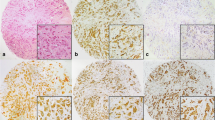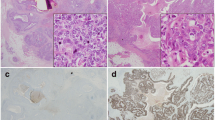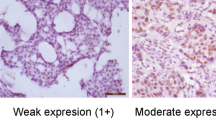Abstract
Purpose
In previous studies, we have shown that SEC62 has an essential function in cell migration, epithelial-to-mesenchymal transition, and endoplasmic reticulum stress tolerance of cancer cells. SEC62 expression correlated with distant and lymph node metastasis and poor outcome in different cancer entities. In this initial study, we investigated SEC62 expression and its possible role as a prognostic and predictive biomarker in breast cancer (BC).
Methods
Formalin-fixed, paraffin-embedded tissue samples of 53 BC patients were analyzed by immunohistochemistry. The immunoreactive score (IRS) according to Remmele and Stegner was evaluated and correlated with clinico-pathological findings and overall survival (OS).
Results
We found increased SEC62 protein levels in tumor tissue compared to tumor-free tissue samples from the same patients. Tumors with high SEC62 expression (IRS > 8), or containing isolated cells with high SEC62 staining intensity, independent of the IRS, had more frequently distant metastases (48.4% vs. 18.2%; p = 0.024 and 47.4 vs. 6.7%; p = 0.005, respectively). Overall survival was significantly worse in BC patients with high SEC62 expression (SEC62 IRS > 8) (54.8% vs. 81.8%; p = 0.011) and in cases with isolated high-intensity SEC62 staining cells independently of SEC62 IRS (55.3% vs 93.3%; p = 0.024).
Conclusions
We are the first to describe the SEC62 expression and its correlation to clinicopathological parameters in mammary carcinoma. Our results suggest that SEC62 expression may serve as a prognostic marker for patients with invasive ductal breast cancer.



Similar content being viewed by others
References
Torre L, Islami F, Siegel R, Ward E, Jemal A (2017) Global cancer in women: burden and trends. Cancer Epidemiol Biomark 26:444
McGuire WL (1973) Estrogen receptors in human breast cancer. J Clin Investig 52:73–77
Horwitz K, McGuire W (1975) Specific progesterone receptors in human breast cancer. Steroids 25:497–505
Slamon DJ, Clark GM, Wong SG, Levin WJ, Ullrich A, McGuire WL (1987) Human breast cancer: correlation of relapse and survival with amplification of the HER-2/neu oncogene. Science 235:177–182
Goldhirsch A, Winer EP, Coates A et al (2013) Personalizing the treatment of women with early breast cancer: highlights of the St Gallen international expert consensus on the primary therapy of early breast cancer 2013. Ann Oncol 24:2206–2223
Zaha DC (2014) Significance of immunohistochemistry in breast cancer. World J Clin Oncol 5(3):382–392
Taneja P, Maglic D, Kai F, Zhu S, Kendig RD, Fry EA, Inoue K (2010) Classical and novel prognostic markers for breast cancer and their clinical significance. Clin Med Insights Oncol 4:15–34
Prat A, Cheang MCU, Martín M, Parker JS, Carrasco E, Caballero R, Tyldesley S, Gelmon K, Bernard PS, Nielsen TONCMP (2012) Prognostic significance of progesterone receptor-positive tumor cells within immunohistochemically defined luminal A breast cancer. J Clin Oncol 31:203–209
Prat A, Parker J, Fan C, Cheang M, Miller L, Bergh J, Chia S, Bernard P, Nielsen T, Ellis M, Carey LA, Perou C (2012) Concordance among gene expression-based predictors for ER-positive breast cancer treated with adjuvant tamoxifen. Ann Oncol 23:2866–2873
Linxweiler M, Linxweiler J, Barth M, Benedix J, Jung V, Kim Y-J, Bohle RM, Zimmermann R, Greiner M (2012) Sec62 bridges the gap from 3q amplification to molecular cell biology in non-small cell lung cancer. Am J Pathol 180:473–483
Jung V, Kindich R, Kamradt J, Jung M, Müller M, Schulz WA, Engers R, Unteregger G, Stӧckle M, Zimmermann R, Wullich B (2006) Genomic and expression analysis of the 3q25-q26 amplification unit reveals TLOC1/SEC62 as a probable target gene in prostate cancer. Mol Cancer Res 4:169–176
Greiner M, Kreutzer B, Jung V, Grobholz R, Hasenfus A, Stöhr RF, Tornillo L, Dudek J, Stöckle M, Unteregger G, Kamradt J, Wullich B, Zimmermann R (2011) Silencing of the SEC62 gene inhibits migratory and invasive potential of various tumor cells. Int J Cancer 128:2284–2295. https://doi.org/10.1002/ijc.25580
Wemmert S, Lindner Y, Linxweiler J, Wagenpfeil S, Bohle R, Niewald M, Schick B (2016) Initial evidence for Sec62 as a prognostic marker in advanced head and neck squamous cell carcinoma. Oncol Lett 11:1661–1670
Bochen F, Adisurya H, Wemmert S, Lerner C, Greiner M, Zimmermann R, Hasenfus A, Wagner M, Smola S, Pfuhl T, Bozzato A, Kadah BA, Schick B, Linxweiler M (2017) Effect of 3q oncogenes SEC62 and SOX2 on lymphatic metastasis and clinical outcome of head and neck squamous cell carcinomas. Oncotarget 8:4922
Greiner M, Kreutzer B, Lang S, Jung V, Cavalié A, Unteregger G, Zimmermann R, Wullich B (2011) Sec62 protein level is crucial for the ER stress tolerance of prostate cancer. Prostate 71:1074–1083. https://doi.org/10.1002/pros.21324
Hagerstrand D, Tong A, Schumacher SE, Ilic N, Shen RR, Cheung HW, Vazquez F, Shrestha Y, Kim SY, Giacomelli AO, Rosenbluh Joseph, Schinzel AC, Spardy NA, Barbie DA, Mermel CH, Weir BA, Garraway LA, Tamayo P, Mesirov JP, Beroukhim R, Hahn WC (2013) Systematic interrogation of 3q26 identifies TLOC1 and SKIL as cancer drivers. Cancer Discov 3:1044–1057
Cheang MC, Chia SK, Voduc D, Gao D, Leung S, Snider J, Watson M, Davies S, Bernard PS, Parker JS, Perou CM, Ellis MJ, Nielsen TO (2009) Ki67 index, HER2 status, and prognosis of patients with luminal B breast cancer. J Natl Cancer Inst 101:736–750
Remmele W (1987) Recommendation for uniform definition of an immunoreactive score (IRS) for immunohistochemical estrogen receptor detection (ER-ICA) in breast cancer tissue. Pathologe 8:138–140
Gospodarowicz MK, Brierley JD, Wittekind C, et al. (eds) (2017) TNM classification of malignant tumours. Wiley, Oxford
Weng L, Du J, Zhou Q, Cheng B, Li J, Zhang D, Ling C (2012) Identification of cyclin B1 and Sec62 as biomarkers for recurrence in patients with HBV-related hepatocellular carcinoma after surgical resection. Mol Cancer 11:39
Troester MA, Hoadley KA, Sørlie T, Herbert B-S, Børresen-Dale A-L, Lønning PE, Shay JW, Kaufmann WK, Perou CM (2004) Cell-type-specific responses to chemotherapeutics in breast cancer. Cancer Res 64:4218–4226
Zhang XH-F, Giuliano M, Trivedi MV, Schiff R, Osborne CK (2013) Metastasis dormancy in estrogen receptor-positive breast cancer. Clin Cancer Res 19:6389–6397. https://doi.org/10.1158/1078-0432.CCR-13-0838
Linxweiler M, Bochen F, Schick B, Wemmert S, Al Kadah B, Greiner M, Hasenfus A, Bohle R-M, Juhasz-Bӧss I, Solomayer E-F, Takacs ZF (2016) Identification of SEC62 as a potential marker for 3q amplification and cellular migration in dysplastic cervical lesions. BMC cancer 16:676
Schmidt-Kittler O, Ragg T, Daskalakis A, Granzow M, Ahr A, Blankenstein TJ, Kaufmann M, Diebold J, Arnholdt H, Müller P, Bischoff J, Harich D, Schlimok G, Gert Riethmüller RE, Klein CA (2003) From latent disseminated cells to overt metastasis: genetic analysis of systemic breast cancer progression. Proc Natl Acad Sci 100:7737–7742
Linxweiler M, Schorr S, Schäuble N, Jung M, Linxweiler J, Langer F, Schäfers H-J, Cavalié A, Zimmermann R, Greiner M (2013) Targeting cell migration and the endoplasmic reticulum stress response with calmodulin antagonists: a clinically tested small molecule phenocopy of SEC62 gene silencing in human tumor cells. BMC Cancer 13:574
Linxweiler M, Schick B, Zimmermann R (2017) Let’s talk about Secs: Sec61, Sec62 and Sec63 in signal transduction, oncology and personalized medicine. Signal Transduct Target Ther 2:17002
Zacharski LR, Moritz TE, Haakenson CM, O’Donnell JF, Ballard HS, Johnson GJ, Ringenberg QS, Schilsky RL, Spaulding MB, Tornyos K (1990) Chronic calcium antagonist use in carcinoma of the lung and colon: a retrospective cohort observational study. Cancer Investig 8:451–458
Jackisch C, Hahm HA, Tombal B, McCloskey D, Butash K, Davidson NE, Denmeade SR (2000) Delayed micromolar elevation in intracellular calcium precedes induction of apoptosis in thapsigargin-treated breast cancer cells. Clin Cancer Res 6:2844–2850
Mahalingam D, Wilding G, Denmeade S, Sarantopoulas J, Cosgrove D, Cetnar J, Azad N, Bruce J, Kurman M, Allgood V, Carducci M (2016) Mipsagargin, a novel thapsigargin-based PSMA-activated prodrug: results of a first-in-man phase I clinical trial in patients with refractory, advanced or metastatic solid tumours. Br J Cancer 114:986–994
Wernicke AG, Varma S, Greenwood EA, Christos PJ, Chao KSC, Liu H, Bander NH, Shin SJ (2014) Prostate-specific membrane antigen expression in tumor-associated vasculature of breast cancers. APMIS 122:482–489. https://doi.org/10.1111/apm.12195
Ghantous A, Gali-Muhtasib H, Vuorela H, Saliba NA, Darwiche N (2010) What made sesquiterpene lactones reach cancer clinical trials? Drug Discov Today 15:668–678. https://doi.org/10.1016/j.drudis.2010.06.002
Denmeade SR, Mhaka AM, Rosen DM, Brennen WN, Dalrymple S, Dach I, Olesen C, Gurel B, Demarzo AM, Wilding G, Carducci MA, Dionne CA, Møller JV, Nissen P, Christensen SB, Isaacs JT (2012) Engineering a prostate-specific membrane antigen-activated tumor endothelial cell prodrug for cancer therapy. Sci Transl Med 4:14–22. https://doi.org/10.1126/scitranslmed.3003886
Fumagalli F, Noack J, Bergmann TJ, Cebollero E, Pisoni GB, Fasana E, Fregno I, Galli C, Loi M, Soldà T, D’Antuono R, Raimondi A, Jung M, Melnyk A, Schorr S, Schreiber A, Simonelli L, Varani L, Wilson-Zbinden C, Zerbe O, Hofmann K, Peter M, Quadroni M, Zimmermann R, Molinari M (2016) Translocon component Sec62 acts in endoplasmic reticulum turnover during stress recovery. Nat Cell Biol 18:1173–1184
Acknowledgements
The authors gratefully acknowledge the excellent work, motivation, and enthusiasm of Mrs. Barbara Linxweiler and Mrs. Alice Kunz.
Funding
The study was funded by the Heinrich Dietz Foundation.
Author information
Authors and Affiliations
Contributions
FZT project development, data collection and analysis, manuscript writing. JCR review and editing. ML data analysis, review and editing. MK data collection, review and editing. RMB project development, data collection, review and editing. FB review and editing, visualization. CU data collection, review and editing. EFS review and editing. BS review and editing. IJB review and editing.
Corresponding author
Ethics declarations
Conflict of interest
We declare that we have no conflict of interest.
Ethical approval
All procedures performed in studies involving human participants were in accordance with the ethical standards of the national research committee and with the 1964 Helsinki Declaration and its later amendments or comparable ethical standards. All patients provided written consent for the use of their tissue samples. The study was approved by the Ethics Committee of Saarland (No: 183/17).
Additional information
Publisher's Note
Springer Nature remains neutral with regard to jurisdictional claims in published maps and institutional affiliations.
Rights and permissions
About this article
Cite this article
Takacs, F.Z., Radosa, J.C., Linxweiler, M. et al. Identification of 3q oncogene SEC62 as a marker for distant metastasis and poor clinical outcome in invasive ductal breast cancer. Arch Gynecol Obstet 299, 1405–1413 (2019). https://doi.org/10.1007/s00404-019-05081-4
Received:
Accepted:
Published:
Issue Date:
DOI: https://doi.org/10.1007/s00404-019-05081-4




